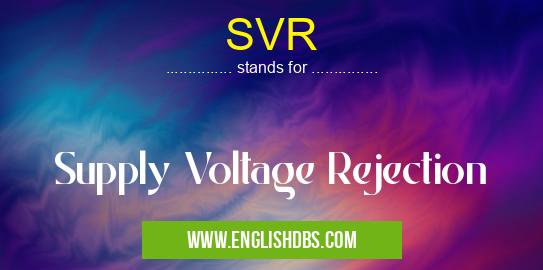What does SVR mean in ELECTRONICS
Supply Voltage Rejection (SVR) is a measure of the robustness of a system when subjected to voltage variations from the power source. It is the ability for a system to reject any changes in supply voltage, also known as ripple or noise, and remain operational. SVR is an important consideration for electronic circuitry that needs to be reliable in varying operating conditions. This concept is typically applied in high-precision electronics such as medical instrumentation, avionics, and industrial process control applications.

SVR meaning in Electronics in Academic & Science
SVR mostly used in an acronym Electronics in Category Academic & Science that means Supply Voltage Rejection
Shorthand: SVR,
Full Form: Supply Voltage Rejection
For more information of "Supply Voltage Rejection", see the section below.
Essential Questions and Answers on Supply Voltage Rejection in "SCIENCE»ELECTRONICS"
What is Supply Voltage Rejection (SVR)?
Supply Voltage Rejection (SVR) is a measure of how well a circuit or device can reject changes in the supply voltage. It is usually expressed as a percentage and this percentage shows what fraction of the variation in supply voltage will appear as a variation in the output.
How can SVR be increased?
Increasing SVR requires using components that are more resistant to change in supply voltage, such as higher-quality capacitors and better power management techniques. Additionally, you can also use circuits like bandgap references to make sure that your circuit’s output remains relatively constant despite variations in the supply voltage.
What does it mean when we say that SVR is "good"?
When SVR is “good”, it means that the variation in output due to changes in supply voltage is very small compared to its nominal value. This means that your circuit outputs will remain relatively close to their desired values even if there are sudden changes in the power being supplied to them.
Why do we care about SVR?
We care about SVR because it allows us to have more reliable operation from our circuits. If we have high SVR, then our outputs will be less affected by variations in our supplies, allowing for more consistent performance across various conditions and operating scenarios.
How can I test my circuit's SVR?
You can test your circuit’s SVR by applying known variations in the supply voltages and then measuring how much these changes affect your output signals with a multimeter. This will give you an idea of how well your circuit handles fluctuations in its input voltages and how robust it is against unexpected changes.
What type of application requires high SVR?
High levels of SVR are usually required for applications where accuracy or consistency of performance needs to be maintained at all times such as industrial controls, medical devices, automotive systems etc. As these applications require repetitively precise operations and responses – they must rely on having good levels of signal stability despite any unforeseen changes or disturbances present within their power supplies.
What technologies help improve an existing design's SVR?
Technologies such as switching regulators, linear regulators, power amplifiers, operational amplifiers or precision references can all help improve an existing design’s SVR significantly when used correctly according to requirements.
Are there any types of circuits that don't need high levels of Supply Voltage Rejection?
Yes - some circuits such as basic amplification stages don't necessarily need high levels of Supply Voltage Rejection as they are not overly sensitive towards variations in their inputs voltages.
Final Words:
Supply Voltage Rejection (SVR) is an essential metric when designing circuits or systems that need to remain reliable under changing operating conditions. Ensuring that components provide adequate protection against fluctuations in power supplies should always be taken into account when designing circuitry used for avionics applications, medical instrumentation and other mission-critical/safety systems where accuracy and reliability are key considerations. Electrical engineers should consult with manufacturers about component specifications that directly improve SVR ratings before integrating them into their designs.
